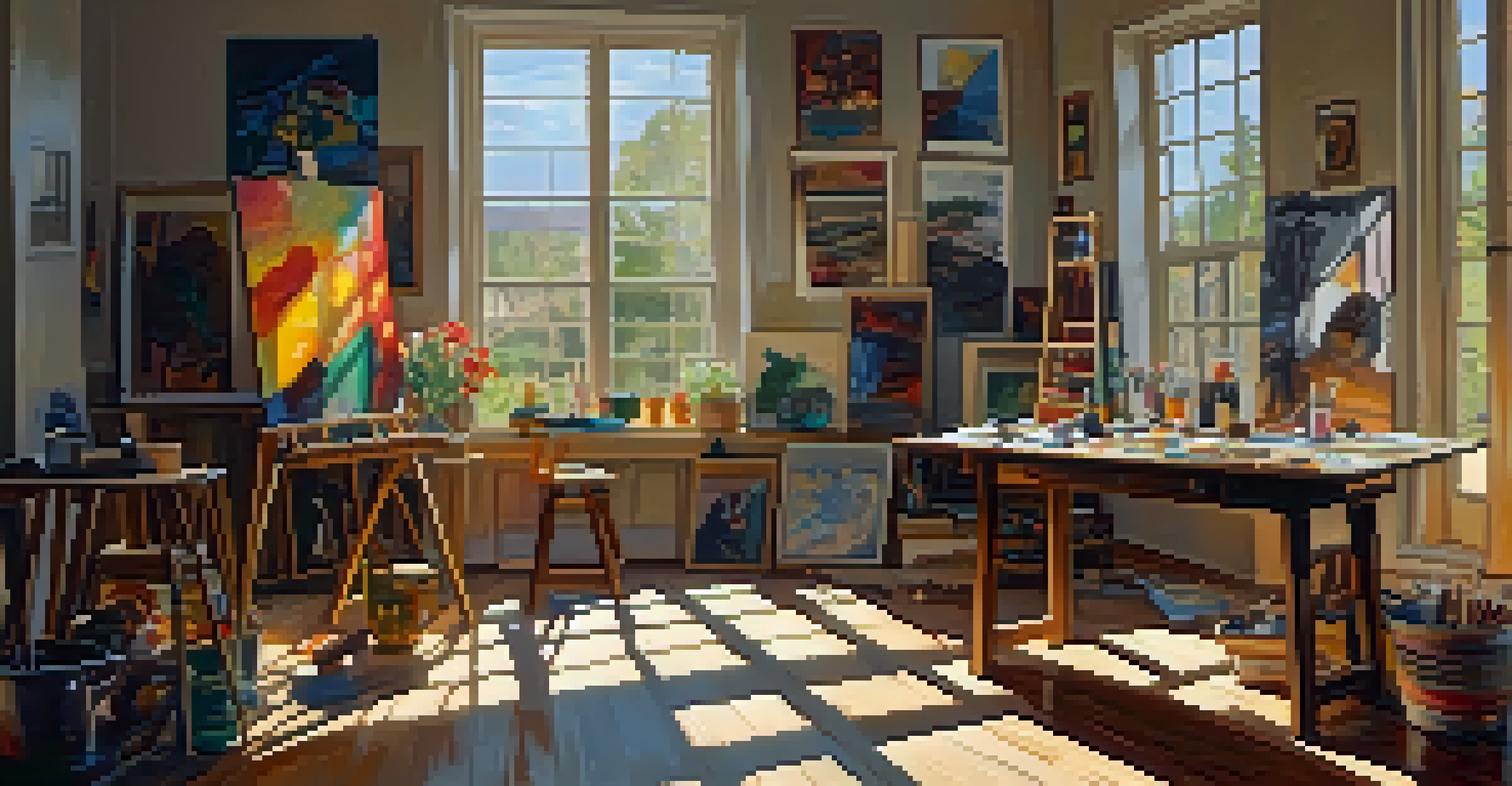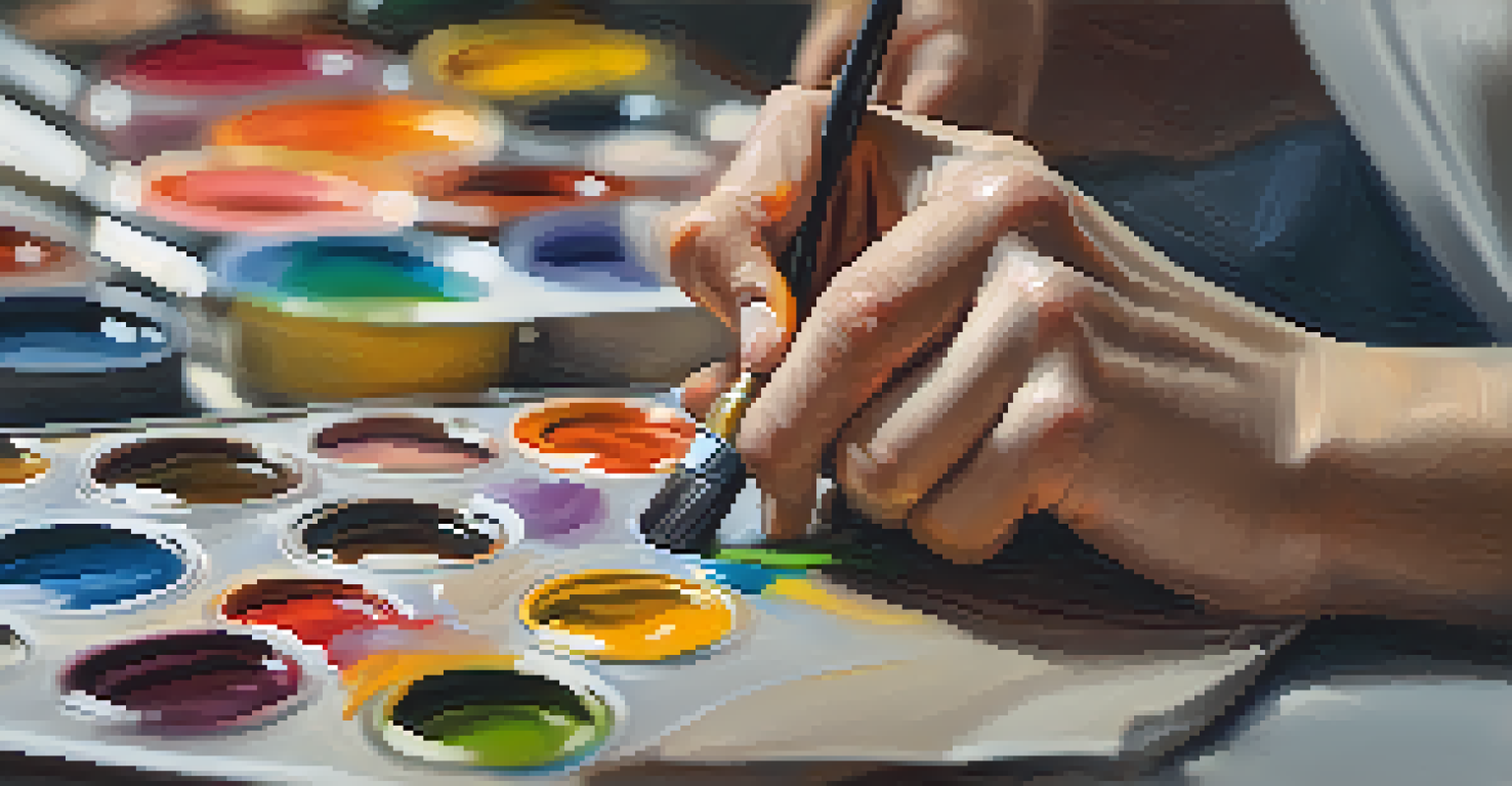Personal Narratives: How Art Reflects Individual Memories

Understanding Personal Narratives in Art
Personal narratives are stories we tell ourselves about our lives, shaped by our experiences, emotions, and memories. Art becomes a powerful medium for expressing these narratives, allowing individuals to communicate their unique perspectives. From paintings to sculptures, artists often infuse their works with personal significance, making each piece a reflection of their journey.
Art is the most beautiful of all lies.
Think of an artist standing before a blank canvas, not just to create but to relive moments from their past. Each brushstroke may echo a childhood memory or a pivotal life event, transforming personal experiences into visual stories that resonate with others. This connection between the artist's life and their art invites viewers to reflect on their own memories.
As we engage with art, we are often drawn to the emotions it evokes, which can trigger our own personal reflections. This symbiotic relationship between the artist's narrative and the viewer's memories fosters a deeper understanding of both the artwork and ourselves.
The Role of Memory in Artistic Creation
Memory plays a crucial role in how artists create and interpret their work. It serves as a reservoir of experiences, influencing choices in color, form, and subject matter. For example, an artist may choose to depict a serene landscape, reminiscent of a peaceful childhood summer, conveying nostalgia and tranquility.

In many cases, memories can be fragmented or unreliable, which adds complexity to the artistic process. Artists might explore these discrepancies by visually representing their recollections in abstract ways, allowing viewers to engage with the work on multiple levels. This approach not only captures the essence of the memory but also reflects the artist's emotional journey.
Art Reflects Personal Experiences
Artists use their personal narratives and memories to create works that resonate emotionally with viewers.
Ultimately, the interplay between memory and art enriches the creative process, offering a space for introspection and exploration. It allows artists to navigate their personal histories while inviting others to see their own stories within the artwork.
Art as a Medium for Healing and Reflection
Art can serve as a therapeutic outlet for individuals grappling with their memories, especially during difficult times. By expressing feelings through creative practices, artists can process trauma or loss, finding solace in their work. This transformative power of art not only aids the creator but can also resonate with viewers who share similar experiences.
The painter tries to master a set of techniques, but the artist's true mastery lies in revealing the soul's story.
Consider a painter who uses dark colors to convey grief or isolation. The intensity of the colors can evoke strong emotions in the viewer, creating a shared understanding of sorrow. This connection often leads to conversations about personal struggles, fostering a sense of community and empathy.
Thus, art becomes a powerful tool for healing, enabling both artists and audiences to confront their memories and emotions. Through this collective journey, art encourages us to embrace vulnerability and find strength in our shared experiences.
Cultural Narratives and Their Impact on Art
Cultural narratives, shaped by societal norms and collective memories, influence artistic expression significantly. Artists often draw on cultural themes to reflect their identities and experiences, creating a dialogue between personal and communal stories. This intersection enriches the artwork, providing layers of meaning that resonate with diverse audiences.
For instance, Indigenous artists may incorporate traditional symbols and narratives into their work, connecting personal memories with broader cultural histories. These artistic expressions not only preserve cultural heritage but also challenge viewers to acknowledge and appreciate those narratives.
Memory Shapes Artistic Expression
The interplay between memory and art enriches creativity, allowing artists to explore their histories while inviting viewers to connect with their own stories.
Ultimately, the integration of cultural narratives in art fosters a deeper understanding of the complexities of identity, memory, and belonging. It highlights how individual experiences can contribute to a larger tapestry of communal storytelling.
The Influence of Technology on Personal Narratives
In today's digital age, technology profoundly impacts how personal narratives are shared and expressed through art. Social media platforms allow artists to showcase their work and connect with audiences globally, amplifying their stories. This accessibility transforms the traditional art world, enabling new voices to emerge and share their memories.
Digital tools also offer innovative ways for artists to create, blending traditional techniques with modern technology. For instance, a digital artist might use software to manipulate images that reflect their memories, creating immersive experiences that engage viewers on multiple sensory levels. This fusion of art and technology encourages experimentation and exploration of personal narratives.
As artists navigate this evolving landscape, they continue to challenge conventions and push boundaries. The result is a dynamic interplay between technology, memory, and art that invites everyone to engage with personal stories in fresh and exciting ways.
Art's Power to Evoke Shared Memories
Art has a unique ability to evoke shared memories, creating a sense of connection among viewers. When we encounter a painting or sculpture that resonates with our own experiences, it often sparks nostalgia and reflection. This phenomenon illustrates how art transcends individual narratives, tapping into universal themes of love, loss, and joy.
Take, for example, a photograph capturing a family gathering. Viewers may see their own family dynamics reflected in the image, prompting discussions about personal histories and traditions. This shared experience deepens our emotional engagement with the artwork, transforming it into a collective memory.
Technology Expands Artistic Voices
Digital tools and social media enable artists to share their personal narratives more widely, fostering new connections and innovative forms of expression.
Thus, art becomes a bridge between individual and communal narratives, allowing us to celebrate our differences while recognizing our shared humanity. In this way, personal memories find a place within a broader context, enriching our understanding of ourselves and each other.
The Future of Personal Narratives in Art
As we look to the future, personal narratives in art will continue to evolve, reflecting the changing landscape of society and individual experiences. Emerging artists are likely to explore new mediums and themes, pushing the boundaries of storytelling in their work. This evolution invites us to consider how our memories shape our identities and the narratives we choose to share.
Moreover, the increasing emphasis on inclusivity in the art world means that diverse voices and perspectives will be amplified. Artists from different backgrounds will continue to share their unique stories, enriching the artistic landscape with a multitude of experiences. This diversity not only enhances the art itself but also fosters greater empathy and understanding among audiences.

In essence, the future of personal narratives in art is bright and full of potential. As we embrace new technologies and ideas, we can expect art to remain a vital medium for exploring and expressing the complexities of memory and identity.